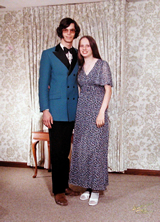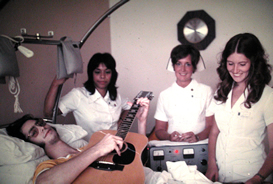Gary Karp – A Man With
a Spinal Cord Injury
A Tragic Moment Turned into a New Life
In 1973 at the age of 18, Gary Karp was one year out of high school, looking forward to beginning architectural school in the fall. This was his long-held dream, inspired by the character of Howard Roark in Ayn Rand's The Fountainhead.
Since the age of eight Gary worked in his father's drugstore, worked for a professional photographer since 13, and did photography and graphic design as a freelancer. He had also been performing as a guitarist/singer since the age of 15.
 Following a major storm in suburban Detroit where Gary grew up, he and several friends were hired by a neighbor to clear his property of broken branches, and to cut down a damaged tree.
Following a major storm in suburban Detroit where Gary grew up, he and several friends were hired by a neighbor to clear his property of broken branches, and to cut down a damaged tree.
The neighbor hired kids to do a job that should have been done by professionals. Gary, like most 18 year old boys, considered himself invulnerable.
He had never held a chainsaw in his life, but it didn't stop him from climbing 25 feet into the tree to take off an upper branch. Although he felt he had a solid stance and was leaning forward against another thick part of the trunk, cutting into the branch caused the tree to lurch, throwing him to the ground.
No one had thought to put a belt or rope around Gary. The neighbor hadn't come out to supervise.
Gary was unable to move or feel his legs the moment he was on the ground. He had broken two vertebrae (T12 and L1) and compressed his spinal cord, cutting off communication from his brain to the lower half of his body.
It was The Fourth of July, 1973. They planned to finish and spend the rest of the day celebrating. Instead Gary spent five hours in surgery to relieve the pressure on his spinal cord and rebuild his spine.
Hospital & Rehab
 Gary awoke in a "Circle Bed" which was used to switch him from his stomach to his back, and then back again, alternating the positions every four hours to prevent pressure sores. He had to lay straight until his spine was healed. This routine was performed day and night for six weeks, during which Gary was he object of a huge outpouring of visitors and support and gifts — while he spent much of his free time watching the Senate Watergate hearings on TV.
Gary awoke in a "Circle Bed" which was used to switch him from his stomach to his back, and then back again, alternating the positions every four hours to prevent pressure sores. He had to lay straight until his spine was healed. This routine was performed day and night for six weeks, during which Gary was he object of a huge outpouring of visitors and support and gifts — while he spent much of his free time watching the Senate Watergate hearings on TV.
Once able to sit up, Gary was transferred to the Detroit Rehabilitation Institute, where for the next seven weeks he was stretched and pumped up and taught the skills he needed to function independently with his paralysis. He was taught "ADLs," Activities of Daily Living. How to dress and manage his basic needs. He learned wheelchair skills, how to manage falling in the chair, how to get back in from the floor, how to transfer into and out of the wheelchair, load it into a car, and navigate the real world of curbs and bumps.
Gary returned home 13 weeks after the fall to learn his father had died the day before. His life had undergone another instant, dramatic change. He resumed what he could of his life pre-paralysis — performing as a musician, being with friends — until it was time to return to school. He had missed his first term in architecture, but was ready to study.
Until he discovered that...
Access & Advocacy
 The architecture building at Lawrence Tech in Southfield, Michigan was completely inaccessible. No level entrance. Gary had to be carried in and out of the building, which became routine as he established ongoing relationships with fellow students. He launched a campaign to make the building accessible. Five years later, a ramp was built at the front, and a mechanical lift was installed inside.
The architecture building at Lawrence Tech in Southfield, Michigan was completely inaccessible. No level entrance. Gary had to be carried in and out of the building, which became routine as he established ongoing relationships with fellow students. He launched a campaign to make the building accessible. Five years later, a ramp was built at the front, and a mechanical lift was installed inside.
Gary's visibility and the skills he gained as an advocate led him to enter student politics to address general issues of concern to architecture students at Lawrence. He was elected president of the Student Chapter of the American Institute of Architects, and the following year served on the national SC/AIA board. His disability experience had led him into arenas and given him skills he might not have otherwise gained.
Professional Life
His idealist vision of Howard Roark gave way to the recognition that his true love and greater talent was graphic design. Gary was one of the first computer graphics production artists in the U.S., working on a Genigraphics workstation to produce 35mm slides for buisness graphics. That career led him to Northern California in 1984 where he was Manager of Computer Graphics at Chartmasters, Inc. in San Francisco, and then founder and V.P. of their groundbreaking Desktop Services Division.
Injured yet again by computing in 1992, Gary was forced to leave his career in graphics having developed chronic tendinitis in his wrists and elbows. True to his pattern of seeking what's possible he began consulting in office ergonomics to spare others from the unnecessary injury he incurred.
Writing online about ergonomics drew the attention of an editor from O'Reilly & Associates, who were considering a new line of consumer targeted medical books. Many long discussions, detailed outlines, and a year later Gary was an author under contract. His book Life On Wheels: For the Active Wheelchair User was published in 1999.
With his first book, his background as a manager, his graphic design skills, and his experience as a performer (by now a juggler as well), Gary was set on the path to be a communicator of the Modern Disability message.
Four books and hundreds of talks later, Gary was inducted into the Spinal Cord Injury Hall of Fame as a disability educator in 2007.
Gary's Story | Gary's Bio
